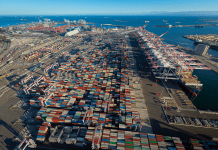
Europe’s clean transport campaign group Transport & Environment (T&E) has published its ranking for European ports in terms of carbon emissions with the port of Rotterdam being on the top of the most polluting ports in the continent.
The port of Rotterdam is associated with almost 14 million tonnes of carbon dioxide (CO2) emissions each year, putting it at the same level of pollution as the Weisweiler coal power plant in Germany, which is Europe’s fifth-biggest industrial polluter.
Antwerp and Hamburg come in second and third place, respectively, while three of the top 10 polluting ports, Algeciras, Barcelona, and Valencia, are in Spain.
Furthermore, Barcelona’s emissions are not accordant to the containers handled, while the Catalan port ranks 10th among Europe’s busiest box ports, but at the same time, it is in fifth place of the most pollutant European ports.

The study estimates that the carbon emissions arise from ships departing and entering ports from across the supply chain, as well emissions from port activities such as loading, unloading and refuelling.
In a year of soaring profits for the shipping industry, T&E calls on ports to follow European Union (EU)-wide efforts to reduce the sector’s climate impact.
“The shipping industry is a fast-growing emitter and Europe’s ports have been reluctant to back mandates for clean fuels,” said T&E in a statement.
The post-Covid rebound in trade has seen container shipping prices soar, but even before the pandemic, ports were handling more and more goods, according to T&E’s data. For example, between 2012 and 2019, cargo volumes at the busiest container port in Europe, Rotterdam port, rose by 13%.
“With container profits at an all-time high last year and shipping companies with profits rivalling those of Apple and Facebook, ports are expected to have had a lucrative year in 2021, too,” pointed out a T&E representative.
“The shipping industry is making a killing right now. Ports are at the heart of this and their climate impact is enormous,” emphasised Jacob Armstrong, sustainable shipping officer at T&E.
“Yet, instead of getting behind proposals to clean up shipping, like comprehensive port electrification and mandates for green fuels, ports simply aren’t doing enough to clean up the sector,” he said.
However, port lobbyists have argued against stricter targets for shore-side electrification which would eliminate pollution in ports and have lobbied against such targets for shipping segments like oil tankers and bulk carriers. This point is particularly bitter for the port communities of Amsterdam and Rotterdam, points out T&E, where oil tankers account for the largest proportion of emissions at port.
Alongside CO2, traditional ships pump significant amounts of harmful gases like nitrogen oxide (NOx) and sulphur dioxide (SOx).

“Ports can have a direct impact in greening our planet by providing clean shipping infrastructure,” explained Armstrong. “This means installing hydrogen-based refuelling infrastructure and shore-side electrification that would allow ships to turn off their engines and plug in at the port,” he added.
T&E advises that the European Commission could help ports by directing revenues from the forthcoming carbon market to clean fuel infrastructure in ports.
The EU’s green infrastructure law (AFIR) is currently under discussion in the European Parliament and the Council, with a final text expected in the second half of 2022, and T&E calls on ports to support the proposal.





